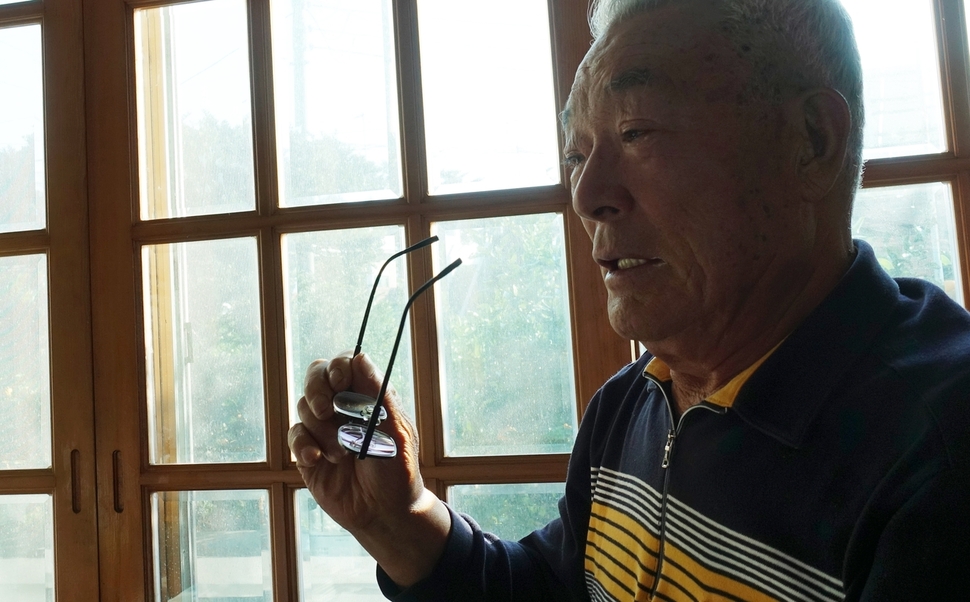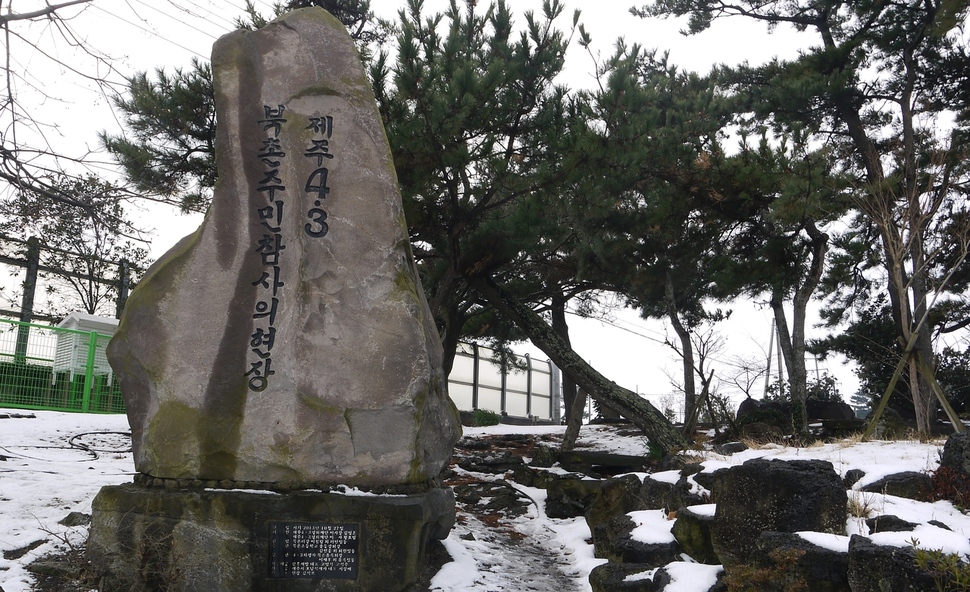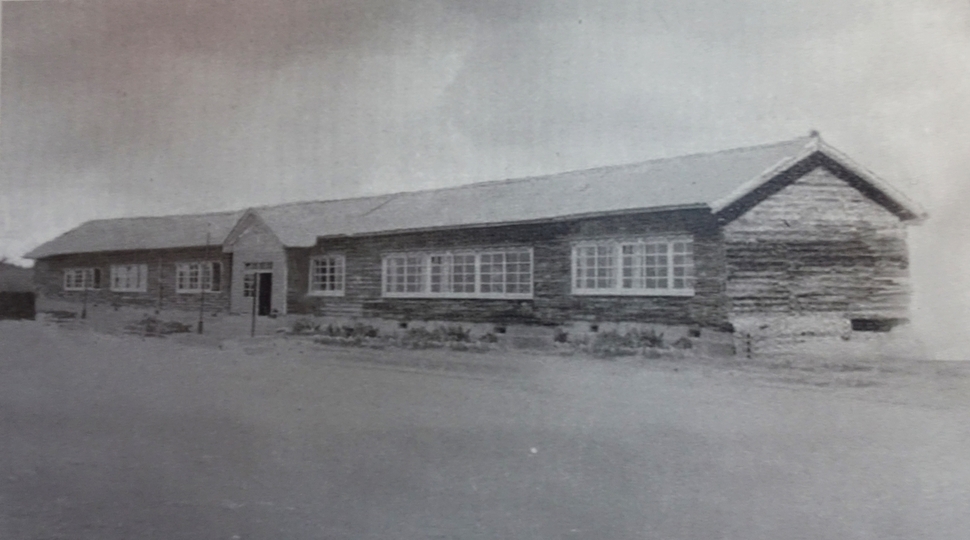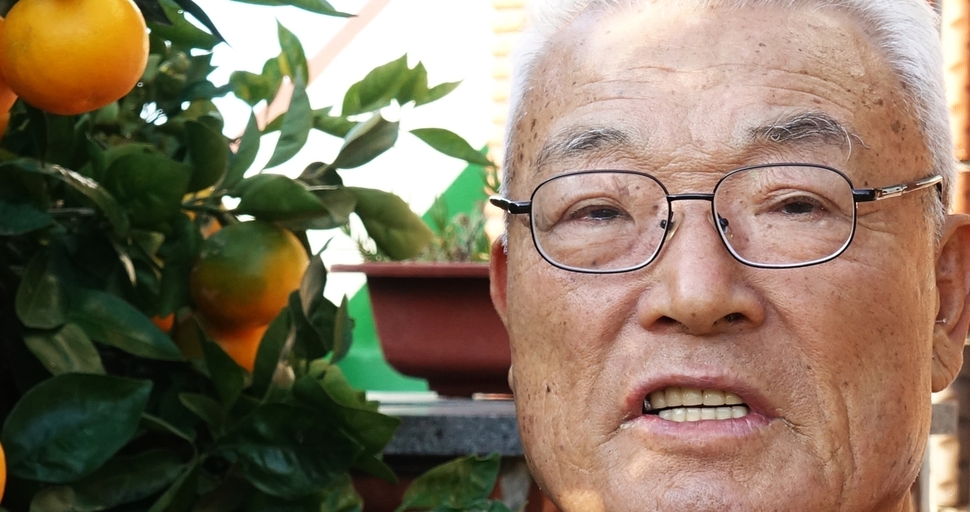 |
|
Lee Jae-hu recalls the events of the Apr. 3 Jeju Massacre in which his father and older sister were killed. (all photos by Huh Ho-joon, Jeju correspondent)
|
Lee Jae-hu recalls the events of the Apr. 3 Jeju Massacre in which his father and sister were killed
Lee Hang-sook and his older in-laws from the same village stared quietly at the sheer face of western Monjugial, watching from hiding in a space among the rocks in Haedong, a community in the Bukchon Village of Jeju Township. A few other Bukchon residents were also there. It was around 5 pm on Dec. 11, 1948, when they heard the rat-a-tat of gunfire. Soldiers lined up women taken from Bukchon on the seaside bluff, pointed their weapons and pulled their triggers; the women dropped down the cliff face like falling leaves.
Haedong is one of the communities passed by Route 18 of the Jeju Olle trails as it winds around Seou Peak next to Hamdeok Beach. Located a little over a kilometer from Bukchon Elementary School, its seaside position affords it a clear view of western Monjugial’s cliff face.
 |
|
The face of the cliff of Monjugial, which is now on Route 18 of the Jeju Olle trails
|
The 2nd Regiment soldiers withdrew sometime later, and Lee joined his in-laws and fellow villagers in carrying the body of his oldest daughter Seon-hwan, then 21, on a stretcher for a temporary burial west of the elementary school. She had been married for just over a year; her husband had been taken first, his fate still unknown.
As the soldiers began routinely engaging in abusing the villagers, Lee’s daughter had joined other young women in hiding in nearby caves. They were discovered by the soldiers anyway, and after suffering all sorts of brutal treatment, they were sent to their deaths on the cliff.
Later that evening after Lee buried his daughter, his wife Won Hee-hwa prepared dinner for him and the in-laws. Nine-year-old Lee Jae-hu was seated next to his mother. His father spoke.
“We buried our daughter with our own hands today, but who will bury us when we die?” he asked. The people seated at the table wept.
“With things developing as strangely as they were, I think my father predicted the fate that would befall him,” recalled Lee Jae-hu, now 79 and a resident of Bukchon in Jeju’s Jocheon Township.
The ones who massacred Lee Seon-hwan and the other young women were soldiers with the 2nd Regiment. They took the women they had found in the caves to the battalion headquarters at Hamdeok.
“I’m not sure of the exact date she was captured, but I know she was held there for about ten days before she was killed,” Lee Jae-hu said.
Five days after his sister’s death, another massacre was carried out in the field at Naensibille on the border between the villages of Bukchon and Dongbok on Dec. 16, 1948. This time the victims were 24 residents and Minbodan members who had cooperated with the military and police as they looked after the village.
 |
|
Lee bursts into tears as he recalls the events he witnessed of the Apr. 3 Jeju Massacre.
|
Entire village of Bukchon set on fire
The village was gripped with even greater fears. On Jan. 17, 1949, the entire village of Bukchon was engulfed in flames. Soldiers set fire to each of the houses in retaliation for the deaths of two unit members ambushed by guerrilla forces at Neobeunsungi near Bukchon Elementary School. They proceeded to herd all village residents young and old onto the school’s athletic field.
“As I left my house to go to the athletic field, I looked back and saw the fires burning brightly,” recalled 85-year-old Lee Seung-jae.
Soldiers also descended with fixed bayonets on Lee’s home on a side street of Bukchon. They used the bayonets to pry open the door and demanded that the family report to the athletic field. Lee’s father was first to go; his mother followed along with his 13-year-old brother and his two sisters, 11 and 4. Lee left the house gripping the hand of his grandmother, then in her mid-fifties.
“I hid in the folds of my grandmother’s skirt and poked my head out like a chick to watch what happened,” he remembered.
“I could see soldiers with guns near the school’s front gate to the south and the eastern and western fences. There were shots fired, and people were dragged outside the school,” he said. The soldiers began taking the residents to a nearby field and shooting them dead. Back at the athletic field, the situation was pandemonium.
According to the “Source Book on Joint Memorial Ceremonies for Victims of the Jeju April 3 Incident,” a total of 282 residents were killed that day alone. One of them was Lee’s father. The site of his death was Gaesuwat, near Neobunseungi. At around 5 pm that day, a jeep from Hamdeok pulled up the commander inside, and the massacre was halted. The third battalion of the 2nd Regiment, which led the slaughter, was nicknamed the “northwest regiment,” consisting mainly of young men from the northwest region of North Korea who had crossed to the South.
Snow flurries mixed with fierce winds, and the village was covered in smoke and the smell of burning. As Lee returned home, he gasped at the stench of burning grain and livestock. Most of the village’s thatched-roof houses had been incinerated. The soldiers had set fire to Lee’s home as well, but the flames had fortunately not spread. Around 20 now-homeless residents gathered at the house. They brought over the scorched carcass of a pig and placed it in a pot to boil. In another pot, they cooked millet.
 |
|
A monument dedicated to the victims of a massacre of Bukchon Village, Jeju Township, during the Apr. 3 Jeju Uprising
|
Too numb and broken to cry
By the lunar calendar, it was the 18th day of the 12th month. The late-rising winter moon reflected over the now smoldering village of Bukchon. Lee’s grandmother stood in the courtyard with him, holding his hand as she addressed the moon.
“Oh mirror-like God, what crime have we committed? Please tell me. We know that the black one is the crow and the white one is the egret. We have shared food at our ancestral rites. We have offered our breasts when there is a crying baby next door. We have placed lids on the crocks when it rains. We have lived in peace. Why, then, did this happen to us?”
Sometime later, Lee’s mother returned. Blood stained her garot (traditional work clothes in Jeju) and the black rubber shoes on her feet. After washing her hands, she entered the kitchen, where around ten of the village’s older residents were gathered.
“I am too filled with grief to cry. Let’s eat now. Eat. We don’t know what will come tonight. We don’t know what tomorrow will bring. Let’s eat our fill before we die.”
“What has become of your father?” one of them asked.
“I found him and covered his corpse with a straw bag,” she replied.
The older residents began to exchange accounts: so-and-so’s mother had died in such-a-such way, so-and-so’s father had been killed at such-and-such place.
The millet was served in wooden bowls, the boiled pork on top of millet straw. The older residents ate both the rice and pork with their bare hands.
“They weren’t in their right minds then, after all they’d gone through that day and the feeling they would most likely die the next. Their husband and wives, parents and siblings were all dead. There weren’t enough tears in the world to cry, but none of them were crying. They were just numb. I’ll never forget the things my grandmother and mother said that day.”
The following day, the Bukchon residents were removed to the nearby village of Hamdeok. Another several dozen people were shot dead there. Lee’s family lived in the barn at his aunt’s house in Hamdeok before finally returning home around Apr. 1949. Bukchon had been left a village without men. The women began joining the bands from their thatched rooms, gathering up the bodies of their husbands, parents, and siblings and beginning the rebuilding of their village. Around the same time, Jeju suffered an outbreak of measles. Children who had escaped the massacres were now claimed by the illness – Lee’s two surviving sisters among them.
 |
|
A photograph of Bukchon Elementary School, where several local villagers were slaughtered during the Apr. 3. Jeju Massacre
|
Teachers and students helping those in need
Lee had been a second-year student in elementary school when the events of the Jeju Uprising began. The school was immediately closed. To this day, he remembers a friend from the same village stealing a sweet potato during his first year at nearby Hamdeok Middle School. Students from Bukchon were scorned as “rioters’ kids.” They were also undernourished: a mixture of mugwort or seaweed with flour had to suffice for a whole day.
“A friend of mine was digging up a sweet potato in the field when the owner came over and he had to run away. The next day, the owner went to the school to complain to the principal. After class, the gym teacher assembled the Bukchon students on the athletic field for a harsh group punishment. We were exhausted, and three of the kids went up to the teacher. One of them began crying and confessed. ‘My father went missing during April 3,’ he said. ‘I’m living with my mother and two younger siblings, and we have nothing to eat at home. Yesterday I came to school and only had water to drink. Teacher, please forgive me.’ I guess the gym teacher was moved, because he said, ‘All right,’ and told everyone to go back. All of the students saw it happen.
The next day, the same teacher left a boxed lunch on my friend’s desk. My friend stood up and shouted ‘Thank you’ at the teacher’s table, even though the teacher wasn’t there. His friends applauded. The class president came out and said, ‘How about holding a campaign to collect handfuls of rice for hungry students?’ And the students applauded that too. Then the second- and third-year students were told, and the student council held a campaign to select small rice donations. That friend of mine who stole the sweet potato spent his whole life bringing happiness to others before he passed away.”
Lee’s mother worked hard. “Now that she had been widowed, my mother kept us fed by carting other people’s things into downtown Jeju to sell them. When tide time came, she would go diving. She plowed fields, and collected firewood to sell on her cart,” he remembered.
 |
|
Lee Jae-hu lost his father and big sister during the Apr. 3 Jeju Massacre.
|
Apr. 3 incident cannot be resolved without state compensation
For the past decade or so, Lee has argued that the April 3 tragedy cannot be resolved without compensation by the state.
“They need to bring the truth to light so we can forgive and proceed onto the path toward harmony. If the government did wrong, shouldn’t it take responsibility? If there is state compensation for the wrongful deaths, I want to use the money to raise a monument. And I want inscribed on the monument a message saying, ‘This monument was erected with government support for those who died in the events of April 3.’”
This is Lee’s heartfelt wish as he approaches his 80th year.
By Huh Ho-joon, Jeju correspondent
Please direct comments or questions to [english@hani.co.kr]














